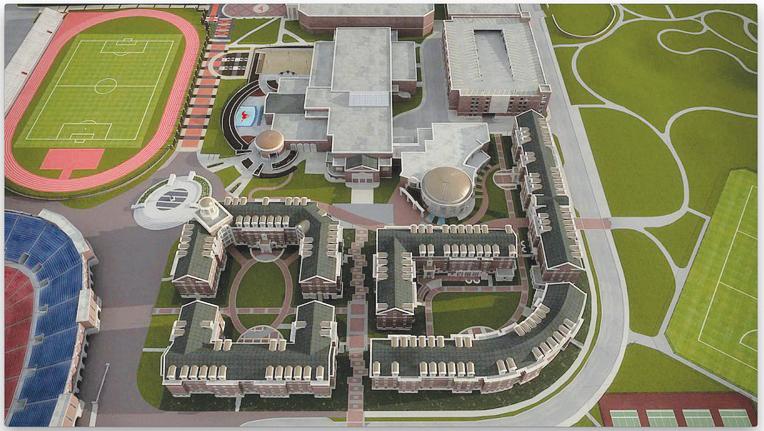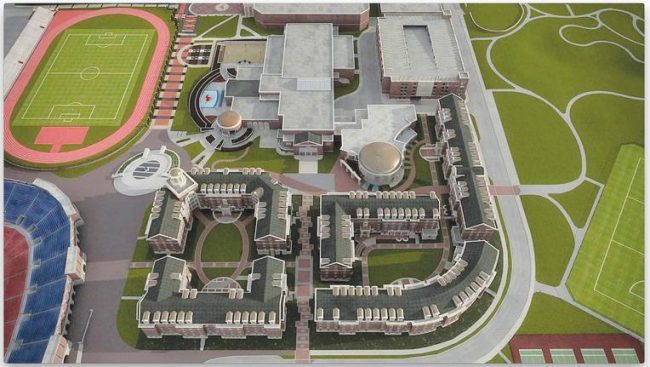
A computer rendering of SMU’s Residential Commons complex. The complex is slated to be open in the fall of 2014. (Courtesy of SMU)
In fall 2014, SMU students will enjoy brand new residence halls, a state-of-the-art dining facility, innovative classrooms, seminar space, another parking garage and their very own professors-in-residence – all part of the new Residential Commons complex.
But as construction begins on the $134.5 million project, current dorm residents already are footing part of the bill for future amenities they likely will not be able to enjoy.
In 2010, SMU officials announced ambitious plans to transfer to a residential commons model with the goal of improving the university academically. So far, SMU has only raised enough donor money for two of five residential halls.
Nevertheless, the university broke ground on April 20 and has plunged ahead to build the entire complex. In addition to donations, SMU will fund the project through bond proceeds and rent revenue, according to a 2010 news release.
What current students may not know is that they are already paying for these future perks. Dorm rent for this academic year and 2012 to 2013 jumped by nearly $300 per year, nearly twice the $150 increase for the 2010 to 2011 year.
Steve Logan, executive director of Residential Life and Student Housing, said “The rationale for the varied increases is tied to the Residential Commons model.”
As a Virginia-Snider resident, Will Slack believes paying a higher rent now will indirectly benefit him.
“I think it’s one of those things that’s a shared sacrifice and a shared reward,” he said.
But Ayen Bior, a student living in Cockrell-McIntosh, said she could use the extra money to buy textbooks and school supplies.
“What upsets me even more is that it will more than likely help students who are fully supported by their parents in the first place but it will leave independent students like myself with a gaping hole in our pockets,” Bior said.
In 2014, when the conversion to the Residential Commons takes place, sophomores will be required to live on campus and almost all existing halls will house freshmen and sophomores together.
According to an average of rent figures published on SMU’s housing website, residence hall rates for 2012 to 2013 will cost $8,367 for double or triple occupancy rooms – the common model.
It’s the second straight year in which rents have climbed by roughly $300, doubling the increase from the 2009 to 2010 academic years.
During the groundbreaking of the Residential Commons, President R. Gerald Turner announced that nine donors have committed $1 million or more, with another nine contributing $100,000 or more towards these facilities.
In total, SMU has raised only $47 million out of $134.5 million, according to an SMU newsletter.
However, Brad Cheves, vice president of development and external affairs, said that fundraising for the commons is on track.
Logan believes this $134.5 million venture is worth it.
He says SMU is one of the few institutions in its peer group that requires its students to live on campus for only one year. He hopes the new model will “continue to attract the high end students academically to SMU,” similarly to what he has seen at Vanderbilt and Rice.
Logan said that in researching this project, SMU has found that universities with two-year live-on requirements have a better campus community.
Sophomores, he said, will have a stronger connection with the university and the campus will see a heavier concentration of students, adding to the vibrancy of the SMU experience.
Allie Feldman, a senior at SMU, said living on campus for two years was a great experience.
“Everything is much more convenient, and you feel more integrated into campus life than you do when you move off campus,” she said.
La Tina Jackson, the residential community director of Cockrell-McIntosh, visited both Vanderbilt and Rice to learn about their residential commons.
Vanderbilt has 10 different residential communities, a student union, cafeteria, gym, convenience store and classrooms exclusive for first-year students.
“It is their selling point when students come for the tour and see, ‘Wow, we have our own community,'” Jackson said.
Some attribute the high retention rate at Vanderbilt to its residential communities.
Its first-year retention rate is 96 percent, which is seven percent higher that SMU’s retention rate of 89 percent.
Vanderbilt has received an increasing number of applicants each year since the implementation of its residential commons model in 2008.
SMU hopes to achieve the same success that Vanderbilt has accomplished.
One way of doing that is by transitioning to a two-year, campus living requirement.
Although developers are taking ideas from different campuses to make the model work, “ours is going to be our own hybrid SMU model,” Logan said.
In addition to multi-class living, one faculty member will live in each residential commons, serving as the academic head of that community.
The faculty will have apartments so they can host students for dinner, movies and discussions. In some cases, they will also teach classes in the commons.
Anthropology adjunct professor Martin Authier already serves as the faculty-in-residence for Virginia-Snider, the honors hall on campus.
He said his position helps him appreciate the complex lives students live outside of class.
For students, “it makes the faculty less intimidating when the students see them doing laundry or carrying their groceries into their apartment,” Authier said.
As SMU hikes up dorm rents to switch to a completely new residential model, Boaz resident Michele Keyes says she is neutral on the subject because she doesn’t pay the bills.
“But I’m sure my dad wouldn’t like it,” she said.











